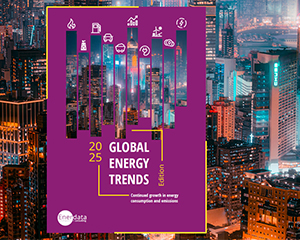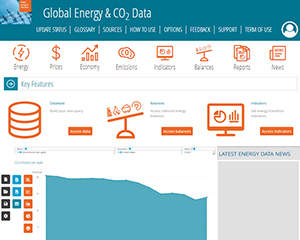Glossar
Anteil der erneuerbaren Energien an der Stromerzeugung
Ratio between the electricity production from renewable energies (hydro, wind, geothermal and solar) and the total electricity production. Electricity corresponds to the electricity produced and transported for commercial purposes, used by ad-hoc devices.
Anteil von Wind und Solar in der Stromproduktion
Electricity produced from wind and solar energy divided by the total electricity production.
Bilanz des Energiehandels
The trade balance is the difference between imports and exports. The balance of a net exporter appears as a negative value (-). The balance of geographic and geopolitical zones is simply the sum of the trade balance of all the countries. Total energy includes coal, gas, oil, electricity, heat and biomass.
Bilanz des Erdgashandels
The trade balance is the difference between imports and exports. The balance of a net exporter appears as a negative value (-). The balance of geographic and geopolitical zones is simply the sum of the trade balance of all the countries. Natural gas is mainly made of methane (CH4). It is marketed after separation of the liquid fractions. The calorific power of natural gas varies according to its methane concentration. The standard coefficient used by Enerdata is: 0.82 toe/m3, for important countries national coefficients are used.
Bilanz des Rohölhandels
The trade balance is the difference between imports and exports. The balance of a net exporter appears as a negative value (-). The balance of geographic and geopolitical zones is simply the sum of the trade balance of all the countries. Crude oil includes all liquid hydrocarbons to be refined: crude oil, liquids from natural gas (Natural Gas Liquid or NGL) and semi-refined products.
Bilanz des Stromhandels
The trade balance is the difference between imports and exports. The balance of a net exporter appears as a negative value (-). The balance of geographic and geopolitical zones is simply the sum of the trade balance of all the countries. Electricity corresponds to the electricity produced and transported for commercial purposes, used by ad-hoc devices.
CO2-Emissionen aus der Brennstoffverbrennung
CO2 emissions cover only the emissions from fossil fuels combustion (coal, oil and gas) by sector. They are calculated according to the UNFCCC methodology (in line with the 2006 IPCC Guidelines for National Greenhouse Gas Inventories).
CO2-Intensität bei konstanten Kaufkraftparitäten
CO2 intensity is the ratio of CO2 emissions from fuel combustion over Gross Domestic Product (GDP). It measures the CO2 emitted to generate one unit of GDP. GDP is expressed at constant exchange rate and purchasing power parity to remove the impact of inflation, reflect differences in general price levels and relate energy consumption to the real level of economic activity. Using purchasing power parity rates for GDP instead of exchange rates increases the value of GDP in regions with a low cost of living, and therefore decreases their CO2 intensities. CO2 emissions cover only the emissions for fossil fuels combustion (coal, oil and gas).
Durchschnittlicher CO2-Emissionsfaktor
The average CO2 emission factor (carbon factor) is calculated by the ratio between CO2 emissions to primary energy consumption.
Energieintensität des BIP bei konstanten Kaufkraftparitäten
The energy intensity is calculated by dividing the total energy consumption of a country by its Gross Domestic Product (GDP). It measures the total amount of energy necessary to generate one unit of GDP. Total energy consumption includes coal, gas, oil, electricity, heat and biomass. GDP is expressed at constant exchange rate and purchasing power parity to remove the impact of inflation and reflect differences in general price levels and relate energy consumption to the real level of economic activity. Using purchasing power parity rates for GDP instead of exchange rates increases the value of GDP in regions with a low cost of living, and therefore decreases their energy intensities.
Erdgasförderung
Natural gas production corresponds to the marketed production (i.e. excluding quantities flared or reinjected). Natural gas is mainly made of methane (CH4). It is marketed after separation of the liquid fractions. The calorific power of natural gas varies according to its methane concentration. The standard coefficient used by Enerdata is: 0.82 toe/m3, for important countries national coefficients are used.
Förderung von Kohle und Braunkohle
Coal production corresponds to gross production. Coal and lignite represent all mineral solid fuels. Their calorific values vary very much from hard coal to lignite (national average coefficients are used).
Gesamte Energieproduktion
The primary production evaluates the quantity of natural energy resources ("primary energy sources") extracted or produced. It includes coal, gas, oil, electricity, heat and biomass production. For natural gas, the quantities flared or reinjected are excluded. Production of hydro, geothermal, nuclear and wind electricity is considered as primary production.
Gesamter Energieverbrauch
For each energy product, it is the sum of primary production, external trade, marine bunkers (fuel used by boats and aircraft for international transport) and stock variations. For the world, marine bunkers are included. This induces a gap with the sum of regions. Total energy includes coal, gas, oil, electricity, heat and biomass.
Handelsbilanz Stein- und Braunkohle
The trade balance is the difference between imports and exports. The balance of a net exporter appears as a negative value (-). The balance of geographic and geopolitical zones is simply the sum of the trade balance of all the countries. Coal and lignite represent all mineral solid fuels. Their calorific values vary very much from hard coal to lignite (national average coefficients are used).
Heimischer Erdgasverbrauch
Consumption (or domestic supply) is the balance of production, external trade and stock changes. Natural gas is mainly made of methane (CH4). It is marketed after separation of the liquid fractions. The calorific power of natural gas varies according to its methane concentration. The standard coefficient used by Enerdata is: 0.82 toe/m3, for important countries national coefficients are used.
Heimischer Stromverbrauch
Consumption (or domestic supply) is the balance of production and external trade. It is mainly divided between power plants, industry, transport and the residential and tertiary sectors, one part is used or lost in the energy transformation. Electricity corresponds to the electricity produced and transported for commercial purposes, used by ad-hoc devices.
Heimischer Verbrauch von Kohle und Braunkohle
Consumption (or domestic supply) is the balance of production, external trade and stock changes. Coal and lignite represent all mineral solid fuels. Their calorific values vary very much from hard coal to lignite (national average coefficients are used).
LNG-Handelsbilanz
The trade balance is the difference between imports and exports. The balance of a net exporter appears as a negative value (-). The balance of geographic and geopolitical zones is simply the sum of the trade balance of all the countries. LNG (liquefied natural gas) is natural gas, mainly made of methane (CH4), that is cooled down at -160°C to become liquid and non-corrosive, and to reduce its volume by around 600 times. LNG can thus be stored in tanks and can be easily transported by ship instead of gas pipelines, increasing the flexibility of global gas trade.
Produktion von raffinierten Ölprodukten
Petroleum products are all liquid hydrocarbons, obtained by the refining of crude oil and NGL and by treatment of natural gas; in particular, LPG production (Liquid Petroleum Gas) includes LPG from natural gas separation plants. The alcohol used as motor fuel in Brazil as well as fuels derived from coal in South Africa are not included in oil products.
Rohölproduktion
Crude oil production corresponds to gross production. Crude oil includes all liquid hydrocarbons to be refined: crude oil, liquids from natural gas (Natural Gas Liquid or NGL) and semi-refined products.
Stromanteil am gesamten Energieendverbrauch
Share of electricity in total final energy consumption.
Stromerzeugung
Electricity production corresponds to gross production. It includes the public production (production of private and public electricity utilities) and the autoproducers, by any type of power plants (including cogeneration). Electricity corresponds to the electricity produced and transported for commercial purposes, used by ad-hoc devices.
Ölprodukte - Handelsbilanz
The trade balance is the difference between imports and exports. The balance of a net exporter appears as a negative value (-). The balance of geographic and geopolitical zones is simply the sum of the trade balance of all the countries. Petroleum products are all liquid hydrocarbons, obtained by the refining of crude oil and NGL and by treatment of natural gas; in particular, LPG production (Liquid Petroleum Gas) includes LPG from natural gas separation plants. The alcohol used as motor fuel in Brazil as well as fuels derived from coal in South Africa are not included in oil products.
Ölprodukte - Heimischer Verbrauch
Consumption (or domestic supply) is the balance of production, external trade and stock changes. Marine bunkers are excluded for countries. They are included at the world level. Consumption is mainly divided between power plants, industry, transport and the residential and tertiary sectors, one part is used or lost in the energy transformation. Petroleum products are all liquid hydrocarbons, obtained by the refining of crude oil and NGL and by treatment of natural gas; in particular, LPG production (Liquid Petroleum Gas) includes LPG from natural gas separation plants. The alcohol used as motor fuel in Brazil as well as fuels derived from coal in South Africa are not included in oil products.
Unsere Ausgabe 2025 von Globale Energietrends bietet Einblicke in wichtige Energiedaten.
Wir haben diese Erkenntnisse im Kontext der langfristigen Klimaziele betrachtet:
- Welche Regionen müssen ihre Anstrengungen beschleunigen, um die Ziele für 2050 zu erreichen?
- Welche zugrundeliegenden Faktoren erklären, warum Europa Schwierigkeiten hat, die Ziele des Klimaabkommens von Paris zu erreichen?
- Welche Regionen leisten wesentliche Beiträge zur Abmilderung des Klimawandels?
Zugang zur umfassendsten und aktuellsten Datenbank des Energieangebots, des Energiebedarfs, der Preise und Treibhausgasemissionen (186 Länder).
- Umfassende Daten
- Jährliche Energie- und THG Emissionsdaten seit 1990
- Bis zu 2000+ Datenserien und Indikatoren je nach Land pro Jahr
- Datenabdeckung für alle Energieträger in 186 Ländern
- 30 Jahre Erfahrung mit Energiebilanzen und -statistiken



